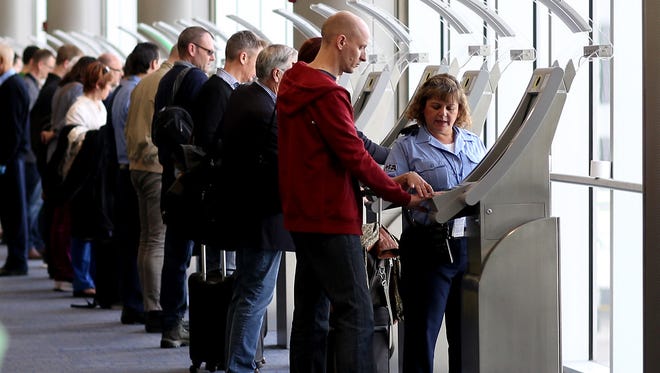Nearly 500K foreigners overstayed visas in 2015
MIAMI — Nearly half a million foreigners who legally entered the U.S. remained here after their visas expired last year, according to a government study that is the first of its kind.

The report, obtained by USA TODAY, is the first analysis of a population that is largely unknown. The so-called "visa overstays" represent an estimated 40% of the 11 million undocumented immigrants living in the country, but are overshadowed by undocumented immigrants who sneak across the nation's southwest border with Mexico.
The results collected by the Department of Homeland Security indicate that those who overstayed their visas are a tiny fraction (1.07%) of the nearly 45 million foreigners who legally entered the country in 2015. Yet the numbers are sure to spark debate about immigration enforcement at a Senate hearing Wednesday where DHS officials will testify about the findings.
Congress first ordered the department to conduct a report on visa overstays in 1997. Members of Congress have spent years asking department officials for the data, only to be told by DHS that it couldn't be compiled.
As the department started distributing the report Tuesday, researchers said it was a welcome first step to understand the magnitude of the problem and figure out the best ways to solve it.
"We're starting to get a better picture of how people flow through the immigration system with this report," said Jeffrey Passel, senior demographer at the Pew Research Center. "But, it's incomplete."
The report studied nearly 45 million international travelers who entered the U.S. through its air and seaports using business and pleasure visas in fiscal year 2015. Of those, it found that 482,781 remained in the country past the expiration of their visas.
Passel pointed to that number to highlight the most obvious problem with the report — since it's the first of its kind, there's nothing to compare it to.
"I can't tell you whether that's larger or smaller than expected," he said. "For now, it's just a partial picture."
But Passel noted that the government will be better served in the future as those numbers come in year after year. For example, in the three months since fiscal year 2015 ended, an additional 66,000 of the people identified as visa overstays had left the country. Passel said it's those kinds of long-term trends that are necessary to understand the nature of those undocumented immigrants.
However long it took to complete, the report is just the start of the congressional mandate issued in 1997. The department was also tasked with creating an "exit-entry" system that can accurately track all people entering and leaving the country.
When foreigners apply for a visa to enter the country, they are interviewed, photographed and have their fingerprints taken before they even reach the U.S. All that work is done at foreign consulates, and gives U.S. officials a full portrait of people entering the country.
Biometric tracking a hurdle for immigration bill
But the difficulty in tracking what happens to those foreigners comes when they leave. U.S Customs and Border Protection doesn't have the ability of getting biometric information — such as fingerprints or iris scans — from every foreigner leaving the U.S. That makes it difficult to figure out who's left and who has remained.
Part of the problem is the way U.S. airports are laid out. Unlike many foreign airports that have separate areas for domestic and international flights, all departing flights from U.S. airports use the same terminals. That makes it difficult for Customs officers to pick out foreign travelers and collect their information.
CBP has conducted several tests in recent years to get the biometric information from travelers leaving the country and is currently operating three pilot programs.
One is using facial-recognition software at John F. Kennedy International Airport in New York City. A separate test is being conducted at 10 of the nation's largest airports, where CBP officers use handheld devices to get the information at departure gates. And a third test is using kiosks at a land border in San Diego where people entering the country have their irises scanned.